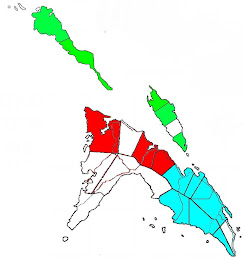ICRMP BACKGROUNDER
Institutional Implementation Arrangements
The Department of Environment and Natural Resources (DENR) is the lead executing agency, in partnership with the Department of Agriculture- Bureau of Fisheries and Aquatic Resources (DA-BFAR) and the local government units.
A Project Steering Committee composed of member-agencies namely the DENR, DA-BFAR, NEDA, DBM, DOF, DILG and the Provincial Government will oversee the project implementation.
Rationale
The Philippine Government started its coastal resource management initiatives in mid-1980. These resulted in significant positive impact on the overall fish catch and biodiversity, promoted good governance and participation local communities. Despite these significant gains, threat to the marine ecosystem still persist due to a lack of an integrated approach to coastal zone planning, policy and institutional weaknesses, weak law enforcement, high poverty incidence among coastal fisher folks and open access to marine and coastal resources.
Having foreseen these problems, President Gloria Macapagal M. Arroyo issued Executive Order 533 in June of 2006, adopting integrated coastal management as a national strategy to ensure sustainable development of the country’s coastal environment and establishing support mechanism for its implementation.
Project Objectives
· To enhance and strengthen policy and institutional capacity for ICRM which includes promotion of sustainable economic livelihood activities and resource management practices.
· To develop DENR’s institutional capacity for CRM coordination and local stakeholders capacity in ecological governance.
· To provide economic and environmental services to ease the pressure on the coastal environment.
Impact and Outcome
The expected impact of the project is enhanced coastal resources. The expected outcome are sustainable management of coastal resources and increased income for coastal communities.
The Department of Environment and Natural Resources (DENR) is the lead executing agency, in partnership with the Department of Agriculture- Bureau of Fisheries and Aquatic Resources (DA-BFAR) and the local government units.
A Project Steering Committee composed of member-agencies namely the DENR, DA-BFAR, NEDA, DBM, DOF, DILG and the Provincial Government will oversee the project implementation.
Rationale
The Philippine Government started its coastal resource management initiatives in mid-1980. These resulted in significant positive impact on the overall fish catch and biodiversity, promoted good governance and participation local communities. Despite these significant gains, threat to the marine ecosystem still persist due to a lack of an integrated approach to coastal zone planning, policy and institutional weaknesses, weak law enforcement, high poverty incidence among coastal fisher folks and open access to marine and coastal resources.
Having foreseen these problems, President Gloria Macapagal M. Arroyo issued Executive Order 533 in June of 2006, adopting integrated coastal management as a national strategy to ensure sustainable development of the country’s coastal environment and establishing support mechanism for its implementation.
Project Objectives
· To enhance and strengthen policy and institutional capacity for ICRM which includes promotion of sustainable economic livelihood activities and resource management practices.
· To develop DENR’s institutional capacity for CRM coordination and local stakeholders capacity in ecological governance.
· To provide economic and environmental services to ease the pressure on the coastal environment.
Impact and Outcome
The expected impact of the project is enhanced coastal resources. The expected outcome are sustainable management of coastal resources and increased income for coastal communities.
PROJECT COMPONENTS
Component A:
Policy and Institutional Strengthening and Development
This component aims at (1) Rationalizing Government Policy for ICRM and improving coordination mechanisms, (2) Strengthening national and local government’s institutional capacity, and (3) Developing a performance based incentives and disincentive system for local governments.
Component B:
ICRM and Biodiversity Conservation
This component will promote basic ICRM practices, i.e., adaptive planning and budgeting, municipal water zoning, law enforcement, pollution control and environmental management resources use licensing, management of foreshores, beaches and mangroves. Participatory and Scientific resource assessment will be conducted in 68 municipal waters nationwide. ICRM plans will be developed and integrated into the municipal planning process. Five ICRM Centers will be established as hubs for biodiversity monitoring and research, training and demonstration activities.
Component C:
Enterprise Development and Income Diversification
This component aims at providing municipal fisher folks with supplementary income and reducing their reliance on fishing by promoting environment-friendly and sustainable enterprises and livelihoods.
Component D:
Social and Environmental Services and Facilities
This component will address the basic social services needs of deprived coastal communities and support local governments’ effort to mitigate coastal pollution and degradation of resources. Eligible projects under this component are public markets, slaughterhouses, bus/jeepney terminals, piers, fish ports, water supply system, day-care centers, add-on classrooms, lying-in clinics and hospitals, farm to market roads, solid waste management, reforestation, mangrove and watershed protection, river and seashore protection, drainage, sewage, etc.
Policy and Institutional Strengthening and Development
This component aims at (1) Rationalizing Government Policy for ICRM and improving coordination mechanisms, (2) Strengthening national and local government’s institutional capacity, and (3) Developing a performance based incentives and disincentive system for local governments.
Component B:
ICRM and Biodiversity Conservation
This component will promote basic ICRM practices, i.e., adaptive planning and budgeting, municipal water zoning, law enforcement, pollution control and environmental management resources use licensing, management of foreshores, beaches and mangroves. Participatory and Scientific resource assessment will be conducted in 68 municipal waters nationwide. ICRM plans will be developed and integrated into the municipal planning process. Five ICRM Centers will be established as hubs for biodiversity monitoring and research, training and demonstration activities.
Component C:
Enterprise Development and Income Diversification
This component aims at providing municipal fisher folks with supplementary income and reducing their reliance on fishing by promoting environment-friendly and sustainable enterprises and livelihoods.
Component D:
Social and Environmental Services and Facilities
This component will address the basic social services needs of deprived coastal communities and support local governments’ effort to mitigate coastal pollution and degradation of resources. Eligible projects under this component are public markets, slaughterhouses, bus/jeepney terminals, piers, fish ports, water supply system, day-care centers, add-on classrooms, lying-in clinics and hospitals, farm to market roads, solid waste management, reforestation, mangrove and watershed protection, river and seashore protection, drainage, sewage, etc.

